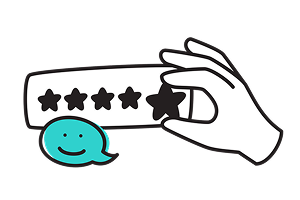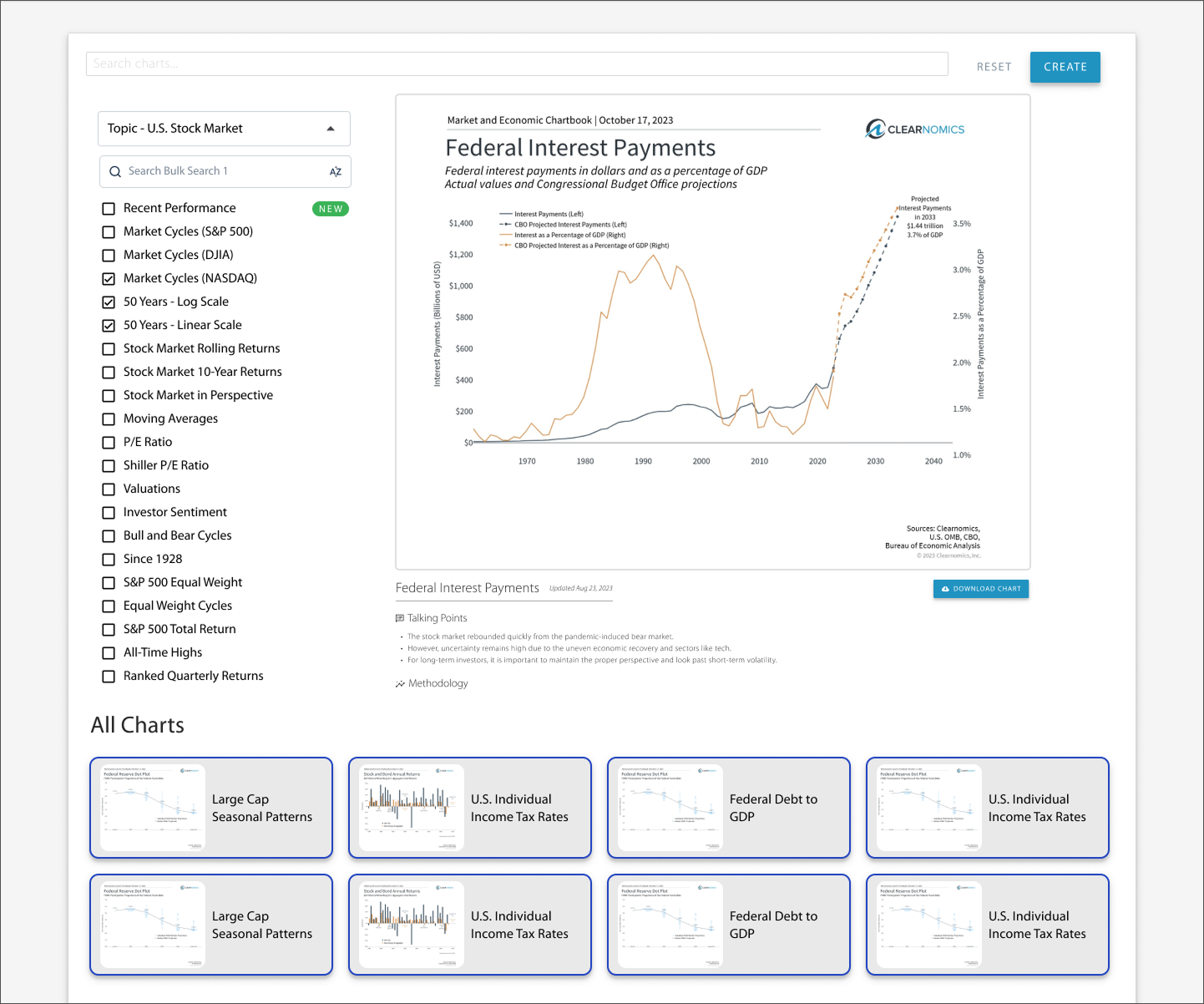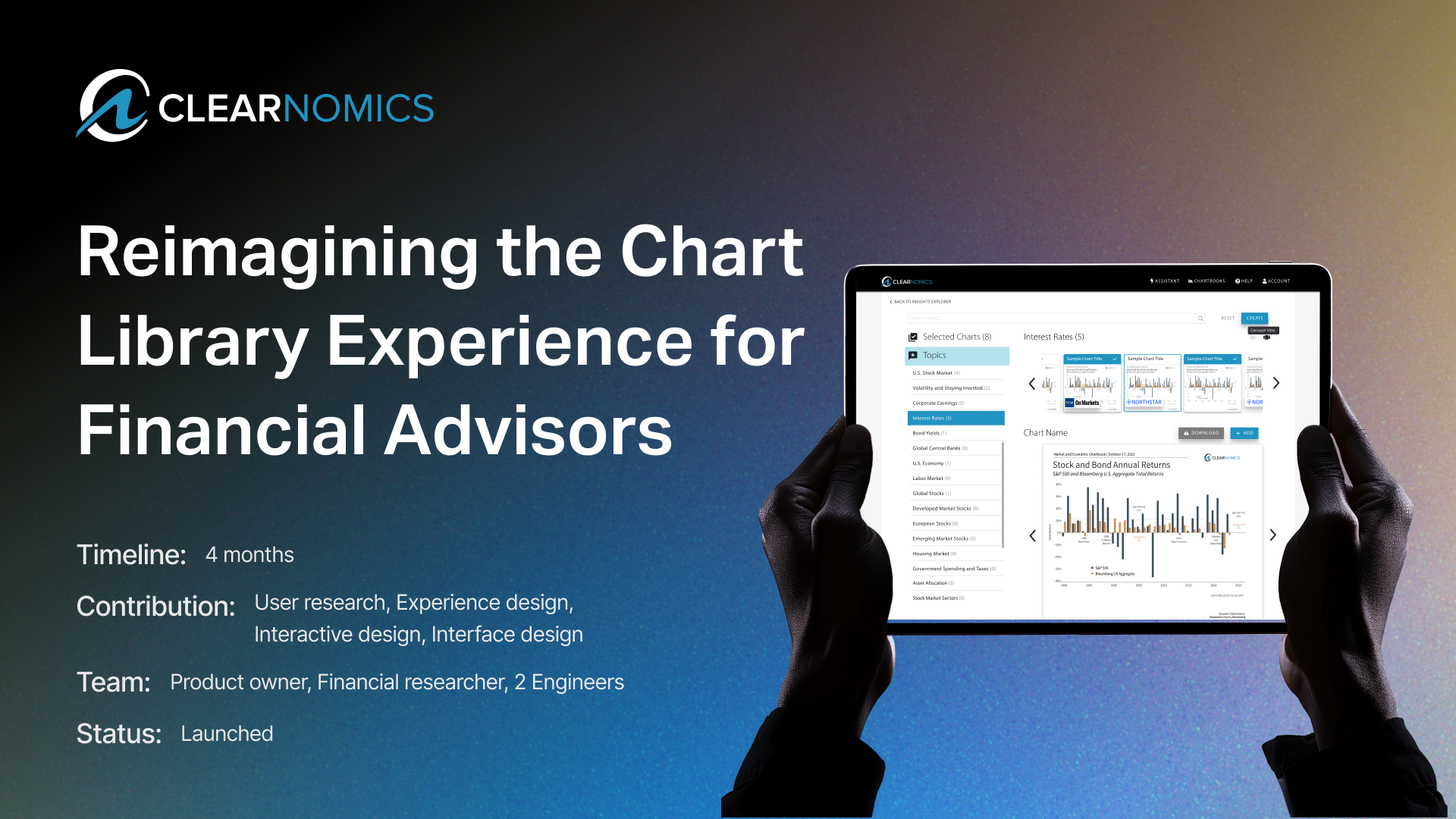
Reimagining the Chart Library Experience for Financial Advisors
Designing clarity and confidence for financial advisors in high-stakes markets
Timeline:
12 weeks (end-to-end from research to launch)
Team:
PM, Content Writer, Financial Researcher, 2 Engineers
Scope:
Strategy • UX Architecture • UI Design • Testing • Delivery
Contribution:
User research, Experience design,
Interactive design, Interface design
Role:
Lead Product & UX Designer
Impact
⬇ Chart access steps: 5 → 1–2
⬆ Usage: 2× increase in first release window
⬆ User satisfaction: clearer navigation, faster workflows
📈 Strategic unlock: foundation for insight recommendations & auto-tagging
+ 20%
+ 300%
+ 25%
Context
Clearnomics builds the leading Insights Platform for Financial Advisors, designed to turn complex financial data into actionable insights.
At the heart of this platform lies the Chart Library (CL) — a curated hub of market, economic, and portfolio visuals that advisors use to communicate with clients.
Over time, however, the CL had become buried, inconsistent, and difficult to navigate. Despite its potential, engagement was low.
My challenge was to rethink this experience from the ground up — not just improving UI polish, but reframing how advisors discover and create insights.
Uncovering the Core Problem
Financial advisors operate in volatile markets where every second counts. They need to interpret data quickly and present it confidently to clients.
Yet the existing Chart Library demanded 4–5 clicks to reach, offered tiny previews, and lacked a clear discovery path.
The real issue wasn’t simply visibility. The system’s structure didn’t align with how advisors think — how they browse, evaluate, and transform data into stories.
I approached it as a systems-level challenge: one of visibility, relevance, and trust.
What our user said
I led interviews with six advisors (new and experienced), mapping their workflows and mental models.
What we learned:
Advisors valued charts not just as data, but as storytelling assets for videos, slides, and client pieces.
New advisors were often lost, while veterans navigated by memory.
The library felt like a dead end. I approached it as a systems-level challenge:
one of visibility, relevance, and trust.
Workshops and journey mapping confirmed this:
Poor hierarchy, high cognitive load, and “dead-end” interactions that eroded confidence.
It became clear — we didn’t just need a cleaner interface, we needed an experience that guided exploration and inspired creation.

At this stage, the team leaned toward surface fixes.
But I pushed us to reframe: not ‘make the library easier,’ but:
How might we make chart exploration feel fast, intuitive, and inspiring for insight creation?
Perspective Shift
This shift opened new directions. We defined two personas:
Exploratory Users (new) – need guidance, categories, and context.
Purposeful Users (experienced) – need precision, speed, and control.
Our bottom-up flow — starting from browsing and selection — served only the latter.
Flipped the model: from bottom-up flow to top-down, topic-first entry point that invited exploration from the first click.
Flipped the model: from bottom-up flow to top-down flow
Competitor Research — Setting UX Benchmarking
To widen perspective, I benchmarked systems known for scale, search, and preview—Google Drive, Spotify, YCharts, Morningstar—asking two questions:
How do they handle scale, search, and preview at speed?
How do they balance open-ended discovery with precise execution?
What consistently worked:
Topic-/collection-first entry to lower cognitive load for new users
Multi-select filters and persistent states (don’t make me re-do work)
Live visual previews to reduce guesswork before committing
Clear, consistent labeling so users always know what they’re looking at
A core principle: the best tools feel faster because they remove decision friction, not because they do more
Design Exploration
Step 1.
We explored seven design directions, testing how best to combine filters, charts, previews, selections, and talking points.
Options 1–2: Filters on the left with grids—efficient for veterans, overwhelming for newcomers.
Options 3–4: Preview as anchor—great for evaluation, but buried navigation.
Option 5: Multi-panel layouts—balanced, but still high cognitive load.
Options 6–7: Topic-first entry—flipped the model, reduced friction, preserved efficiency.
Step 2. Touchpoint for Chart Library
Finding the right home for the Chart Library turned out to be as much an organizational challenge as a design one.
I proposed and validated three directions:
A standalone tab for clarity and separation
Embedding it directly on the homepage (ultimately chosen)
Merged with “My Insights” for long-term consolidation
Version 1
A light-touch refresh—quick wins but shallow impact.
I led two rounds of usability testing, co-facilitated synthesis with PM and Engineering, and merged the best of V2 and V3 into the final product — balancing what we could ship now with a scalable foundation for later.
Version 2
A redesigned interface with live previews —better usability, but harder onboarding and confusing for new users.
Version 3
A fully reimagined system—resonated strongly, but required careful scoping for delivery.
Navigating Product & Org Complexity
Homepage placement proved a strategic win:
it boosted discoverability, aligned with advisor workflows, and set the stage for deeper integration.
Every design decision was made with clarity and future growth in mind, balancing near-term impact with long-term scalability.
I prioritized:
Empowering new users to drive adoption—directly aligned with our business growth strategy;
Staying with familiar interaction patterns to reduce cognitive load and ease the learning curve;
Designing a modular system that could evolve as future needs emerged;
I approached this not as a one-off redesign, but as a strategic platform move—delivering value today while laying the groundwork that could adapt and grow over time.
The Final Experience
Flow: Homepage → Chart Library → Browse → Preview → Select → Create
Key Features
Topic-first navigation — intuitive entry for new users.
Visual filters + toggleable views — adaptable to workflow.
Carousel previews — fast scanning of multiple charts.
Creation modal — one-click generation of articles, chartbooks, or videos.
We intentionally avoided complexity creep, focusing on clarity, speed, and scalability.
Building & Testing
After prototype validation, I partnered with engineers to deliver a component-based build that maintained UX integrity.
Rigorous QA ensured visual quality and performance parity between prototype and production.
Two rounds of testing informed refinement:
Default sorting → “Most used” with persistent filter states.
Keyboard shortcuts + persistent view toggles for power users.
The live system reflected real advisor behavior — not just design intent.
Reflection
This project taught me that:
Curiosity reveals deeper problems than certainty.
Transformation often comes from rethinking entry points, not adding features.
Designing for dual personas isn’t compromise — it’s orchestration.
More than a redesign, this was a strategic repositioning of how advisors engage with insights — proof that clarity builds trust at every level of product design.























